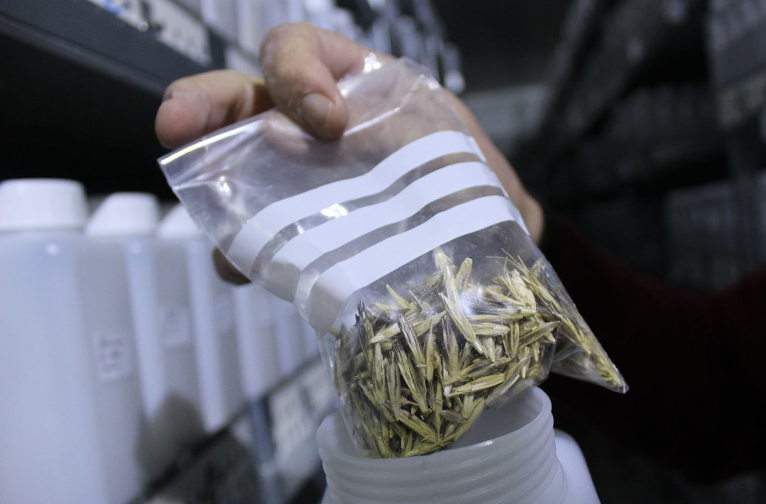Dr. Ali Shehadeh never meant to be a hero. But when conflict erupted in Syria in 2012, threatening the work of the International Center for Agricultural Research in the Dry Areas or ICARDA, Shehadeh took matters into his own hands.
Called a “legume maniac” by his colleagues while studying for his doctorate in Birmingham, England decades earlier, Shehadeh was one of 90 senior staff working in Tal Hadya, Syria, at ICARDA’s flagship mission. The genebank, established there in 1983, is part of an international consortium of genebanks around the world that aim to secure wild and cultivated varieties of nearly every seed in the world.
A small man with a dainty mustache, the 63-year old has spent over 28 years “serving” ICARDA he says, totaling over 26 collection missions and 13 botanical surveys. “I spent half of my life in the field collecting seed,” he says wistfully when I visited ICARDA’s offices in Lebanon to hear his tale of rescue.
Violence related to the conflict began cropping up for the Tal Hadya station in June 2012, when a militia group attacked the station, burgling 100 vehicles. In the interest of protecting staff, foreign and national employees relocated to Aleppo, at the time thinking the move was temporary.
Then, two staff were kidnapped and everyone, except for the local Tal Hadya staff, were barred from the station. Even Dr. Shehadeh was forced to stay at headquarters in Aleppo. Luckily, part of ICARDA’s mission is to rely heavily on local staff, so the station was able to keep running basic functions.
During this time, Shehadeh, and others at ICARDA, realized that they needed to get as many specimens out of their genebank as possible. The conflict in Syria was only getting worse and there was no date when they could expect to return. “We continued even under siege,” says Dr. Shehadeh. “We never stopped.”
And what had previously been a 30 minute trip between their headquarters in Aleppo to the Tal Hadya became nearly 40 hours, as they had to traverse the countryside, zig zagging away from checkpoints controlled by militias. “We had to get the seeds out,” says Ali. “You have to be creative.”
While Ali organized the rescue of thousands of varieties of pulses, legumes, and grasses, he also needed to keep the generators running at Tal Hadya, in order to keep the genebank a chilled -20c and 0c degrees. This required 5,000 liters of diesel a week, which was difficult to find. Like Sisyphus, each week they scrambled to procure the fuel; turning the generators off could destroy decades of work. Shehadeh was determined not to let them too become a casualty of war.
From Aleppo, Shehadeh coordinated shipments to other genebanks in Turkey and Lebanon, until October 2015, when even local staff were forbidden by ICARDA to return to Tal Hadya station. In addition to the genebank partners, Shehadeh sent two major shipments to the Svalbarg Global Seed Vault in Norway, totaling over 116,000 varieties.
The Tal Hadya station, as well as it’s Lebanese counterpart in Terbol, lie in the Fertile Crescent, which has been farmed for over 10,000 years, according to archaeological finds. The area stretches in a boomerang shape from the Nile River in Egypt, across the Levant and Mesopotamia down to the Persian Gulf. The importance of ICARDA’s mission in the region is precisely because of the area’s history as the origin of many crops, as well as a land bridge between Africa and Asia as human civilization was developing.
“The advantage of having the gene bank here is that the wild varieties came from here,” says Shehadeh.“Without knowing the evolution of the wheat, you can do your breeding?”
The “work of ICARDA…is important globally and certainly in the future is going to be one of the central resources we have for climate change adaptation,” says Cary Fowler, the founder and agronomist behind The Svalbarg Global Seed Bank. Fowler was speaking in the documentary, Seeds of War, which chronicles the work of ICARDA to save over a hundred thousand varieties of seed. In the documentary, Fowler says that ICARDA’s work on drought-resistant or so-called “hot crops”… “will save many lives in the future.”
As seed diversity plummets globally, securing varieties will likely become even more important. ICARDA counterparts and fellow genebanks in the Philippines, Afghanistan, and Iraq have been lost due to human interventions and natural disasters, making the success of ICARDA’s move from Syria even more commendable.
ICARDA’s employees had the foresight to send their genetic duplicates to Svalbarg, becoming the first genebank to deposit their stores there in 2015. Their leadership in many ways paved the way for other genebanks around the world to follow suit.
And now, in 2019, the seeds have returned to the Fertile Crescent after Svalbarg’s safe keeping. The black box with the original seeds that were first deposited in Svalbarg was returned to Lebanon in 2016 and planted to grow three more sets: one that will be stored at Terbol, Lebanon in an extra cold vault, one that will be sent to other genebanks, and then a third that will be sent back to Svalbarg for storage.
“The genebank of [Tal Hadya] was considered the icon of ICARDA,” said Shehadeh. “We were very proud that we were contributing to the knowledge of the world.”
And from the looks of it, the work of Tal Hadya will continue to contribute to the knowledge of the world, just with a slight location change.





